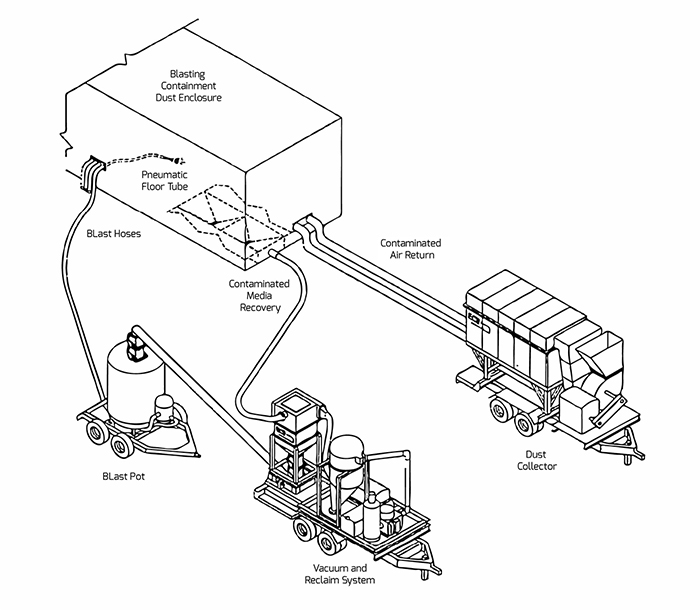
Practical advice for blasting big metal structures in closed tanks
20.07.2017

When blasting in closed tanks is done while using metallic abrasives, the suppliers offer complete information about their lifetime and their recover option.
Metallic abrasives offer the possibility to obtain a high level of productivity during surface treatment operations. Furthermore, in their case the negative impact on environment is highly diminished and the dust emission is also reduced.
When blasting in closed tanks, the recovery and cleaning operations cannot take place simultaneously if the working spaces are too small or too complex. As a consequence, one might need to consider charging the equipment with a quantity of abrasive, which is sufficient enough for operating during one shift.
The equipment must include ventilation, dehumidification and dust collectors. A typical setting is schematically presented below.

In order to take advantage of all benefits offered by metallic abrasives it is recommended to integrate a set of compressors able to generate high pressure. When finishing the blasting operation the abrasive recovery is to be done with the help of an industrial vacuum cleaner.
Ideally one should use high capacity abrasive silos (10-20 tones) able to insure the continuity of the production process during an entire shift, so there will be no need to periodically refill them with new quantities of steel shots.
The blasting equipment should be capable to operate at minimum 8 bars so that one can work with nozzles of 6 to 8 bars. This way a cleaned surface will be worked out in short periods of time. In order to maintain the level of productivity the abrasive quantity should be completed according to the following “thumb rule”: after using the steel shots during 10 to 20 cycles one should add 1-2% of new abrasives into the silos.
Compressors
As mentioned above it is recommended to use compressors able to generate 8 to 10 bars at a normal debit of 5-7 Nm3/min/operator.
Dust collectors
Even if using metallic abrasives generates low quantities of dust during blasting, it is clear that the cleaning of the surface itself generates impurities due to old paint’s and rust’s elimination.
In order to maximize the security and improve the productivity and visibility during operation high capacity dust collectors are necessary. The ventilation system in the working area is also extremely important.
Dehumidification
The high level of humidity registered in most shipyards generates the condense appearance which leads to rustiness. Dehumidification is, under these circumstances absolutely necessary for insuring a high quality result of the surface treatment and its preparation for painting. Units with capacities between 5000 and 15000 m3/h are usually installed for applications in the maritime industry. The dehumidifiers are mobile and can be set wherever needed on the site.
Abrasive recovery
After blasting, the abrasive is recovered using industrial vacuum cleaners and dust collectors.
Abrasive cleaning station
This element is probably the most important one from the entire solution. It needs 2 elements: a mechanic separator for eliminating the paint particles and other contaminants alike and an air assisted cleaning system that should help eliminating the dust and other impurities. These 2 elements should process between 5 and 10 tones of abrasive per hour in order to be compatible to the needs registered in shipyards.
Abrasive silo
After the used and collected abrasive passed through the cleaning station it is returned to the specially designed abrasive silos from where it can be reintegrated in the process and reused afterwards.









